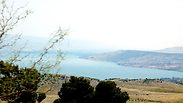
The Sea of Galilee
צילום: גלית קוסובסקי
Another dry February with a serious drought in the North
For the third year in a row, northern Israel sees very low precipitation, with the Water Authority providing a grim prediction: Even if March is rainy, it won't change the situation.
The month of February was arid at a level recorded only twice before, the Water Authority said Thursday, after tallying up the amount of the rainfall over the past month in particular, and during the winter months in general.

"Unfortunately, the month of February ended as the Water Authority had predicted, a severe drought in the north of the country for the third consecutive year," the Water Authority said a statement. "We we worried about having a third year of low precipitation, and we even prepared in advance and reduced pumping from the Sea of Galilee. However, when looking at the main winter months, even experienced professionals are surprised."
According to the Authority, the lowest rainfall amounts measured in history were in 2014, measurements considered rare. "But only two years have passed and already we find ourselves in a similar situation, and the amounts of precipitation to date are lower by 50 percent in relation to the long-term average," said the Authority’s spokesman Uri Shor. According to him, the situation is better by only a few millimeters than what was measured in 2014.
"Even if more precipitation falls in March, we do not expected much change in the situation of the national water reserves," he added. "This is because the heat waves we've been hit with quite often recently dried out the ground, as if we were in the summer."
According to Shor, looking at the situation through a wider perspective reveals a worrying picture: during the last decade, only two or three years had average amounts of precipitation, and the rest of the years had drought.

Siphoning from the Sea of Galillee has been restricted. (Photo: Andrei Mazlin) (צילום: אנדריי מזליין)
Water officials in the Golan Heights say that this year is indeed a third year of drought, but the measures are slightly better than those taken in 2014. With a touch of cynicism, the CEO of the Mei Golan corporation, Eitan Sade, noted that "there is tough competition who would kill us first: the weather or the Israeli government," referring to the government decrees on agricultural imports and the transfer of responsibility for water resources to the Mekorot company.
"In the northern Golan, only 400 mm of rain has fallen so far and in the centeral Golan, only about 250 mm of precipitation was registered," he added. "About half of what falls during a good year. The problem is that the long-term average shrinks as all the bad years accumulate. "
He said reservoirs in the Golan are only a third full, and even this amount is partly thanks to pumping done from the Shamir springs and the Sea of Galilee. "Filling of the reservoirs, even in a good year, depends on the rain's dispersal and distribution, but we're talking about the third year in a row - a lot more rain needs to come down in order to fill the reservoirs. "
Sade however is not giving up hope: "If March is rainy and good, maybe we can get through the year."











